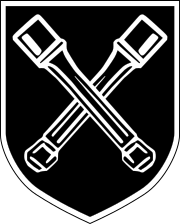
Back لواء ديلوفانا Arabic 36-я грэнадзёрская дывізія СС «Дырлевангер» Byelorussian 36-а вафен-гренадирска дивизия на СС Bulgarian 36vet rann SS grenadennerien Breton 36. granátnická divize SS Czech 36. Waffen-Grenadier-Division der SS German SS-Sturmbrigade Dirlewanger Spanish لشکر سی و ششم وافن-گرندیر اساس Persian 36. Waffen-SS-divisioona Finnish 36e division SS French
| Dirlewanger Brigade | |
|---|---|
| German: 36. Waffen-Grenadier-Division der SS | |
 Division insignia | |
| Active | 1940–45 |
| Country | |
| Branch | |
| Type | Infantry |
| Role | Bandenbekämpfung (security warfare; literally "combating of bandits") |
| Size | Brigade Division |
| Nickname(s) | Black Hunters |
| Engagements | World War II |
| Commanders | |
| Notable commanders | Oskar Dirlewanger |
The Dirlewanger Brigade, also known as the SS-Sturmbrigade Dirlewanger (1944),[1] or the 36th Waffen Grenadier Division of the SS (German: 36. Waffen-Grenadier-Division der SS), or The Black Hunters (German: Die schwarzen Jäger),[2] was a unit of the Waffen-SS during World War II. The unit, named after its commander Oskar Dirlewanger, consisted of convicted criminals. Originally formed from convicted poachers in 1940 and first deployed for counter-insurgency duties against the Polish resistance movement, the brigade saw service in German-occupied Eastern Europe, with an especially active role in the anti-partisan operations in Belarus. The unit is regarded as the single most brutal and notorious Waffen-SS unit,[3][4] with its soldiers described as the "ideal genocidal killers who neither gave nor expected quarter".[5] The unit is regarded as the most infamous Waffen-SS unit in both Poland and Belarus.[6]
During its operations, the unit participated in the mass murder of civilians and other atrocities in German-occupied Eastern Europe. It gained a reputation among Wehrmacht and the Waffen-SS officers for its brutality. The unit epitomized the "anti-partisan activity on the Eastern front that emerged from the image of the hunt and the animalization of the enemy".[7]
According to French historian Christian Ingrao, Dirlewanger's unit committed the worst atrocities of the Second World War.[8] The unit killed at least 30,000 civilians in Belarus alone,[9][10] with up to over 120,000 killed and 200 villages destroyed by Dirlewanger's unit in Belarus.[11] Several members such as Hans von Cullen were put to death post-war by ad-hoc tribunals. Several commanders attempted to remove Dirlewanger from command and to dissolve the unit, but powerful patrons within the Nazi apparatus protected Dirlewanger and intervened on his behalf. Amongst other actions, the unit took part in the destruction of Warsaw in late 1944 and in the massacre of more than 50,000 of Warsaw's inhabitants in August 1944 during the Warsaw Uprising – as well as in the brutal suppression of the Slovak National Uprising of August to October 1944.
- ^ Cite error: The named reference
Williamsonwas invoked but never defined (see the help page). - ^ Cite error: The named reference
:0was invoked but never defined (see the help page). - ^ MacLean, French L. (1998). The Cruel Hunters: SS-Sonderkommando Dirlewanger Hitler's Most Notorious Anti-Partisan Unit. Schiffer Military History. pp. 12–13. ISBN 978-0764304835.
- ^ Bishop, Chris (2003). SS: Hell on the Western Front. Staplehurst: Spellmount. p. 92. ISBN 1-86227-185-2.
- ^ Finder, Gabriel N.; Prusin, Alexander V. (2018). Justice Behind the Iron Curtain: Nazis on Trial in Communist Poland. University of Toronto Press. p. 220. ISBN 978-1-4875-2268-1.
- ^ Snyder, Timothy (2010). Bloodlands: Europe Between Hitler and Stalin. Basic Books. p. 303. ISBN 978-0-465-00239-9.
- ^ Westermann, Edward B. (2021). Drunk on Genocide: Alcohol and Mass Murder in Nazi Germany. Cornell University Press. p. 79. ISBN 978-1-5017-5421-0.
- ^ Schlagdenhauffen, Régis, ed. (2018). Queer in Europe During the Second World War. Council of Europe Publishing. p. 32. ISBN 978-92-871-8464-1.
- ^ Bartrop, Paul R.; Grimm, Eve E. (2019). Perpetrating the Holocaust: Leaders, Enablers, and Collaborators. ABC-CLIO. p. 75. ISBN 978-1-4408-5896-3.
- ^ Kay, Alex J. (2021). Empire of Destruction: A History of Nazi Mass Killing. Yale University Press. p. 271. ISBN 978-0-300-26253-7.
- ^ Гриневич, Е.М.; Денисова, Н.А.; Кириллова, Н.В.; Селеменев, В.Д. (2011). Адамушко, В.И.; Баландин, В.В.; Дюков, А.Р.; Зельский, А.Г.; Селеменев, В.Д.; Скалабан, В.В. (eds.). Трагедия белорусских деревень 1941–1944: Документы и материалы [The Tragedy of Belarusian Villages 1941–1944: Documents and Materials] (PDF) (in Russian). Фонд «Историческая память». pp. 6, 411. ISBN 9-785-9990-0014-9.
© MMXXIII Rich X Search. We shall prevail. All rights reserved. Rich X Search